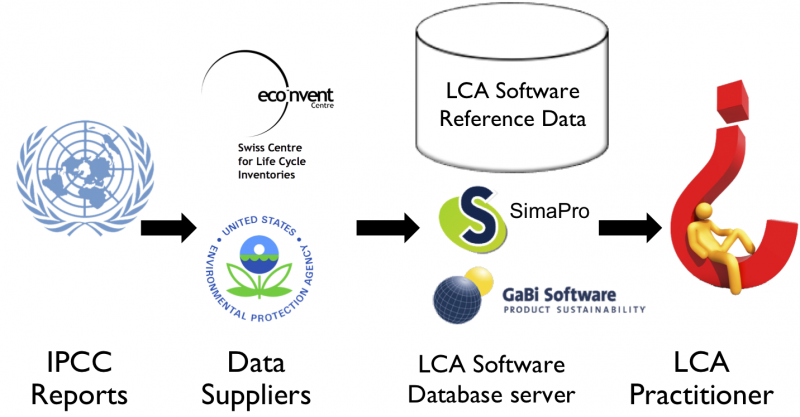Excerpts from an interdisciplinary research project for my Bachelor of Science degree, with support from the Columbia Department of Earth and Environmental Engineering

This Parallel Coordinates graph shows 6 software implementation versions of greenhouse gas Global Warming Potential CO2 equivalency factors for the integration of radiative forcing over 100 years. The substances are ordered by red (lowest) to magenta (highest) from left to right data series. Diagonal lines indicate differences between series. To display negative and zero values, a hybrid-log scale approach was used, adapted from (Bagwell 2005); values 10 to 24,000 were scaled by taking the natural logarithm, to ensure continuity values -1 to <10 were multiplied with (ln(10)/10).
To make sense of the above graph, view a list of greenhouse gases represented by the lines (with corresponding color legend) in Appendix A of the thesis document.
Abstract
Engineers, product designers, and business strategists are seeking ways to benchmark the impact of greenhouse gas emissions. To measure and model greenhouse gas emissions for Carbon Footprint certification and comparisons between design iterations and competitors, a list of greenhouse gases emitted per each functional unit of a product or service is transformed into a total kilogram amount of Carbon Dioxide equivalents (CO2eq) by using a list of Global Warming Potential (GWP) CO2 equivalency factors. Currently, there is no automated way to check what exact implementation or version of GWP CO2 equivalency factor reference data is used for Carbon Footprinting — a subset of Life Cycle Assessment (LCA). A sensitivity analysis of six food and beverage product Carbon Footprint data sets shows that different implementations of GWP CO2eq factors used in software for Life Cycle Assessment (LCA) can result in a 0.33 kg or >359% difference in total kg CO2eq size of a product’s Carbon Footprint. Interviews with an LCA software provider and three practitioners show that different lists of GWP CO2 equivalency factors are used by LCA practitioners and that no cross-platform machine readable metadata is used for versioning. As methodologies and reference data for Carbon Footprinting are likely to keep evolving, metadata documentation, validation and rigorous version control of GWP CO2 equivalency factor reference data is important. In conclusion, a recommendation is made to inform the design of a web based tool that will facilitate comparison, validation, and certification of GWP reference data used in Carbon Footprint calculations.

Simplified Diagram of the process of calculating a carbon footprint of a bottle of sports drink, with some of the ingredients (e.g. corn, water, sodium chloride), the packaging (polyethelene), also included would be the electricity involved in manufacturing the product (e.g. from coal, hydropower), the transport of the product in its various stages, and emissions caused by the disposal of the product.
5. Recommendations
5.1 Carbon Footprint (meta)data formats and conversions

Simplified Diagram of the GWP CO2 equivalency factor information flow. This is how the numbers published in the UN IPCC translate to real world carbon footprinting calculation. The LCA data suppliers under consideration in my study are the Swiss Ecoinvent Centre and the U.S. EPA, which makes data available as part of the Tool for Reduction and Assesment of Chemical and other Environmental Impacts or “TRACI”.
3.2 Sensitivity analysis
3.2.1 Results

Carbon Footprints calculated using same basline data with different equivalency factors lists in SimaPro software, up to 0.35 kg difference in total Carbon Footprint for the 4.5 oz Bag of Cookies between TRACI 2005 (light grey) and TRACI2 2008 (white)
5.3 Feature requirements for Global Warming Potential CO2eq factor Validation Tool
5.3.1 Tool Summary
This software specification was designed to facilitate the validation of greenhouse gas GWP CO2 equivalency factors used for Carbon Footprinting datasets. The tool is to be hosted by an international organization (IPCC, UNEP) and made available via the internet. The tool consists of two parts:
- A list of current greenhouse gas GWP parameters formatted in standardized (EcoSpold XML ) database format
- A web based validation tool, available free of charge through a Grahical User Interface (GUI) and accessible from Life Cycle Assessment software with an API key
5.3.2. Target Audience
- Life Cycle Assessment practitioners in industry
- Academic researchers
- Policy makers
- Anyone who wants to validate greenhouse gas global warming potential parameters
5.3.3. Global Warming Parameter Validation Tool Overview
The tool should:
- Verify reference data when LCA data sets are imported in a project and when comparison calculations are made.
- Be compatible with current commercial and open source data transfer formats, reference databases and product lifecycle applications
- Be open source so as to be available to commercial software providers, open source developers, university researchers, regulatory organizations and individuals with limited means
- Be compatible and available as a free add-in for existing proprietary and open source software.
- Feature unique identifiers for substances